|
Books in series are popular with readers of all ages. This column includes reviews of recently published books for young readers: first books in new series, some much anticipated sequels, and the latest books in episodic series that can be read in any order. These books will leave emergent and newly independent readers eagerly awaiting the release of the next book and reading—and rereading—earlier books in the series as well as seeking similar series. 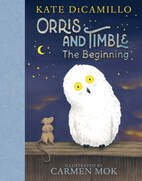 The Beginning (Orris and Timble #1). Kate DiCamillo. Illus. by Carmen Mok. (2024). Candlewick. Orris the rat lives in solitude in a nest behind a hole in the wall of an abandoned barn with his treasures: a red velvet slipper, a marble, and an Imperial Sardine can with a portrait of a king and the words “Make the good and noble choice!!” One evening Orris hears a cry for help and cautiously approaches a young snow owl, Timble, who flew in through a window and got his foot caught in a mousetrap. While talking about “The Mouse and the Lion” fable and heeding the advice of the king pictured on his sardine can, Orris pries open the trap. Timble takes flight only to appear at the hole in the wall wanting to hear the end of the fable. This is not the end of the story of Orris and Timble, however, but rather the beginning. (PreK Up) 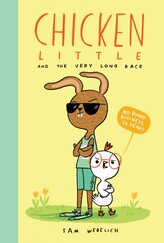 Chicken Little and the Very Long Race (The Real Chicken Little #3). Sam Wedelich. (2024). Scholastic. On the title page of Sam Wedelich’s new picture book tale in cartoon format in the Real Chicken Little series, the cute, white-feathered chick wearing oversize, red glasses and snazzy red cowgirl boots expresses her reluctance to participate in a very long race. Seeing the bad influence Hare, the local record holder and self-promoter of Hop to It: Hare’s Guide to Running, is having on the flock’s training program, however, she decides to train for the upcoming marathon. On the day of the event, Chicken Little’s “SLOW AND STEADY” approach to the challenge of running a very long race has Hare, who stops to sign autographs for his fans, coming in second. On the final page, Chicken Little is pictured pondering what other challenges she could try. (PreK-Gr 2) 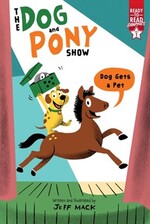 Dog Gets a Pet (The Dog and Pony Show #1). Jeff Mack. (2024). Simon Spotlight. Dog gets a pet as a surprise gift from Pony. Upon opening the box with holes in the sides after making some wild guesses about which animal he is getting, Dog is disappointed to see a rock and not the T. rex he really wanted. When Pony suggests that he will like his new pet rock more after giving it a name, Dog calls her Lulu—"Lulu the T. rex who likes to eat ponies.” After a day spent doing other things that Lulu likes to do, Pony says it is Lulu’s nap time. Once Pony reassures Dog that Lulu won’t eat him either, he says, “Pony, I love my new pet. Even if she is just a rock” and settles down for a nap with Lulu. We Are Up a Tree!, the second adventure of Dog and Pony in Jeff Mack’s new Level 1 Ready-to-Read Graphics book series, will be published in September. (PreK-Gr 2) 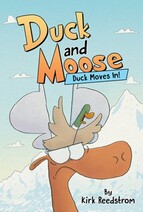 Duck Moves In! (Duck and Moose #1). Kirk Reedstrom. (2024). Disney Hyperion. It is springtime when Duck, a new arrival to the forest, spies the perfect site for his new home—the space between the antlers on Moose’s head. “This will be my forever home. Hiya! I’m Duck.” Exuberant, loquacious Duck’s nonstop chatter has Moose, who does not want to exchange his peace and quiet for “PEACE and QUACK” (the saying on Duck’s sampler), tries to relocate him with no success. When Duck throws a noisy housewarming party atop his head, Moose has had enough. “I said NO! You can’t live there, Duck! . . . because it’s my HEAD!!!” Duck departs and Moose is once again alone—or is he? Chapter 3, “Return of the Duck,” reveals a satisfying ending to this first book in Kirk Reedstrom’s humorous early graphic novel series. Moose Blasts Off! was published simultaneously; Duck in the Dark! will be released in December. (PreK-Gr 2) 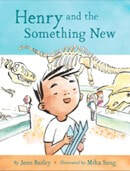 Henry and the Something New (Henry #2). Jenn Bailey. Illus. by Mika Song. (2024). Chronicle. Henry, a young neurodivergent child, is excited about Class Ten’s field trip to a museum but he is also a bit worried about getting there because he has never ridden on a bus. Henry listens as his teacher goes over the rules for the visit, but gets distracted when a huge, noisy bus drives up to the school door and doesn’t hear the third rule. At the museum, Henry responds to “What should we see next?” with a loud “DINOSAURS!” and his group does a special activity in the Bone Room and has a tour of Dinosaur Hall with a scientist. Mika Song’s expressive illustrations rendered in watercolor and ink complement this warm and gently humorous early chapter book in which, at the end of the day, Henry realizes that he actually followed Rule Number Three: Find something new. (PreK-Gr 2) 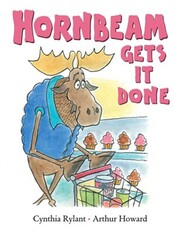 Hornbeam Gets It Done (The Hornbeam Books #2). Cynthia Rylant. Illus. by Arthur Howard. (2024). Beach Lane. Cynthia Rylant and Arthur Howard offer young readers more humorous short stories in this second picture book in their new early reader series about a moose named Hornbeam and his friends. In “March Worries,” Eureka, his neighbor gander, comes up with a sensible solution to Hornbeam’s problem of protecting a little blueberry bush (as well as a lot of other things) in his yard from blowing away during the windy month of March. In “Food-Shopping,” a red-faced shopper helps Hornbeam and Cuddy, a bull, solve their problem of not getting past the yummy cupcakes at the baked goods counter right inside the front door to do their weekly Monday food-shopping: enjoy eating cupcakes and reading the newspaper on Monday mornings and put hot peppers in their mouths so they won’t want cupcakes and do the shopping on Tuesdays. In “Game Night,” Eureka hosts a monthly gathering of all the friends to play board games. “And no matter who won, everybody went home happy!” (PreK Up) 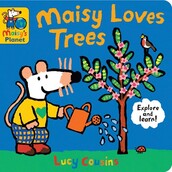 Maisy Loves Trees (Maisy’s Planet #1). Lucy Cousins. (2024). Candlewick. Preschoolers can explore and learn about trees with Maisy, Lucy Cousins’ beloved mouse character, in this first book in the new board book series Maisy’s Planet with Cousins’ signature style artwork featuring Maisy and her friends done in bright colors and outlined with thick black lines and a simple text. Basic information that answer questions such as “What is a tree?” and “Where do trees grow?” is paired with scenes clearly showing that Maisy loves trees. A final fold-out page shows Maisy and her friends Tallullah, a chick, and Cyril, a squirrel, at a park seeing trees from all over the world (cypress, traveller’s palm, baobab, monkey puzzle tree, and willow). “Trees are amazing. Maisy loves them all!” Maisy Loves Bees was published simultaneously; Maisy Loves Water will be out in September. (PreS Up) 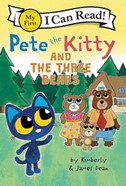 Pete the Kitty and the Three Bears (Pete the Kitty #7). Kimberly Dean & James Dean. Illus. by James Dean. (2024). Harper. “Once upon a time . . .” Pete the Kitty saw the empty house of the three bears while walking in the woods. No one was at home. Kimberly and James Dean give the Goldilocks tale an update as Pete the Kitty enters, eats Baby Bear’s just right pizza, plays and breaks a string on his just right guitar, and takes a nap in his just right bed. When Papa, Mama, and Baby Bear return home, they see what Pete has done and discover him still in Baby Bear’s bed. Here is where the Deans’ plot takes a big twist from the classic tale as Pete feels bad about his behavior and says he is sorry. “Everyone makes mistakes.” says Mama Bear; “We forgive you, Pete,” says Papa Bear; “Let’s be friends,” says Baby Bear. (PreK-Gr 2) 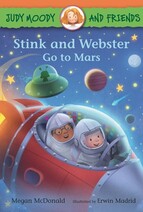 Stink and Webster Go to Mars (Judy Moody and Friends #15). Megan McDonald. Illus. by Erwin Madrid. (2024). Candlewick. Stink is planning his first-ever sleepover with his best friend, Webster. Judy, of course, is ready to advise him on the sleepover rules: 1. Have a theme, 2. Have an activity, 3. Have snacks, and 4. Don’t sleep. Webster’s arrival in his outer-space pajamas sets the theme, a trip to Mars. The boys convert Stink’s race-car bed into a spaceship, Sleep Rover SW1 (S for Stink, W for Webster, and 1 for their first sleepover). “Blastoff time!” The text, peppered with aerospace terminology, describes their activities including a spacewalk and an encounter with a Martian; the colorful digital illustrations show that their adventurous journey to the red planet actually takes place in Stink’s bedroom. Ignoring Judy’s “You cannot sleep” rule, the two tired Mars-o-nauts fall asleep after planning a sleepover trip to Venus for the next weekend. (PreK-Gr 2) 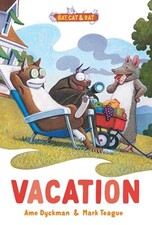 Vacation: Three-and-a-Half Stories (Bat, Cat & Rat #2). Ame Dyckman. Illus. by Mark Teague. (2024). Beach Lane. The trio of unlikely friends who moved in together in The Cozy Home (2024) is now ready for a vacation. In story #1 “Working,” they do odd jobs to refill their Vacation Jar—but not without some mischief. In story #2 “Choosing,” they must decide on a destination. Bat suggests outer space, Cat suggests the spa, and Rat suggests the buffet. When the time comes to choose on the count of three, “OUTER SPACE!” says Bat and “THE SPA!” says Cat. “EEK! says Rat. In story #2-and-a-half “Bickering,” Cat and Bat continue their squabble, and Rat leaves the house pulling a wagon with the Vacation Jar in it. In Story #3 “Vacationing,” Rat returns and interrupts Bat and Cat’s bickering and shouts, “EXCUSE ME! We don’t need a destination!” He has a telescope for Bat’s outer space choice, a lounge chair and cucumber slices for Cat’s spa choice, and a variety of snacks for his own buffet choice. “Their cozy home had everything they needed for THE BEST vacation!” (PreK-Gr 2) Carolyn Angus is former Director of the George G. Stone Center for Children’s Books, Claremont Graduate University, in Claremont, California.
0 Comments
Nicole Maxwell & Carolyn Angus In memory of beloved children’s author Beverly Cleary (1916-2021), who was born on April 12, April is Drop Everything and Read (D.E.A.R.) Month, an annual celebration inspiring teachers and students in their classrooms and families at home to take 30 minutes a day to read for pleasure. Join in the celebration by reading some of the books reviewed below this month and keep it going throughout the year by enjoying reading together recently published books as well as old favorites. 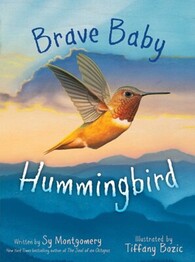 Brave Baby Hummingbird. Sy Montgomery. Illus. by Tiffany Bozic. (2024). Paula Wiseman. “I am one of the lightest birds in the sky.” In naturalist Sy Montgomery’s latest picture book, a hummingbird tells the story of his early life, hatching from a tiny egg in a nest no bigger than a quarter two days after his sister and being fed every twenty minutes by their mother. One day, however, he does not feel the breeze of his mother’s hovering wings that signals her return to them with food. By nighttime, the baby birds are scared, cold, and hungry. The next day, the two are rescued. Montgomery’s informative story of these orphaned baby birds and their development under the care of trained hummingbird rehabilitators until they are ready to be released into the wild is enhanced by Tiffany Bozic’s stunning acrylic artwork featuring the male hummingbird and his sister, as well as other species of hummingbirds. Back matter includes an author’s note, a “Hummingbird Highlights” section on the characteristics and behavior of the amazing hummingbird, and suggestions on how readers can help hummingbirds in their own backyards. (PreK Up) —CA 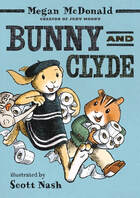 Bunny and Clyde. Megan McDonald. Illus. by Scott Nash. (2024). Candlewick. Tired of being good, best friends Bunny Elizabeth Parker (a rabbit) and Clyde Chestnut Wheelbarrow (a chipmunk) decide to become baddies. Knowing nothing about how to be bad, they head to the library and check out books about characters who are good at being bad, including Interrupting Chicken, The Tale of Two Bad Mice, and Bad Kitty. Their first attempts at doing bad stuff in the neighborhood, such as pulling up all the pretty little yellow flowers (actually dandelions) in Darby the squirrel’s yard and toilet papering all of the rose bushes in Thorton the possum’s garden on a frosty night, end up being good deeds. Thinking bigger and “badder,” Bunny and Clyde make their own Wanted Dead or Alive poster and do the “biggest, baddest” thing they can think of, rob a bank (the librarian Rowena’s piggy bank). The heist doesn’t go as planned but leaves them enjoying a tasty penny candy reward and thinking about what to do the next day. Readers will be eager to discover what the duo will be up to in the sequel. (PreK Up) —CA 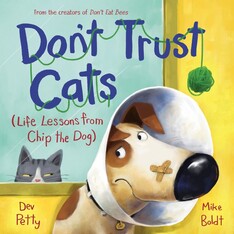 Don’t Trust Cats (Life Lessons from Chip the Dog #2). Dev Petty. Illus. by Mike Boldt. (2024). Doubleday. In this hilarious picture book, Chip the Dog from Don’t Trust Bees (2022) is back with more life lessons. His primary lesson this time, of course, is not to trust cats. While Chip specifically references the family cat, Mittens, he also cautions against trusting cats that are “fluffy,” “stripy,” or have “big eyes.” Still, he assures the reader that there are plenty of other things you can trust, like your people, even though they lied that one time about going to the park and you ended up at the vet. The squirrels and birds you always chase that laugh “with you, not at you” are trustworthy, along with the skunk who looks like he wants to be friends. Mike Boldt’s vivid comic illustrations pair well with the text to portray an energetic, entertaining, and trusting (maybe too trusting at times) dog with a big, shiny nose and perfect puppy eyes. (PreK-Gr 2) —NM  Finally Heard. Kelly Yang. (2024). Simon & Schuster. In the sequel to Kelly Yang’s middle grade novel Finally Seen (2023) in which Lina Gao was reunited with her family, who left her behind with her grandmother in Beijing when they immigrated to the United States, is navigating new challenges in fifth grade. She is taller than her classmates, uncomfortable in her own skin, and one of the only two students in the class without a phone. Even her mom has discovered the potential of going viral on social media to grow her bath bomb business. When she finally gets a phone, Lina thinks that being seen and heard online is just what she needs to build her confidence until she finds there is more to the world of social media and group chats than she ever expected. There is so much to see and process it is confusing and overwhelming. At least her two best friends, Carla and Finn, are by Lina’s side to help her manage this new set of challenges. Back matter includes an author’s note and an informative “Essential Research on Social Media and Kids.” (Gr 3 Up) —NM 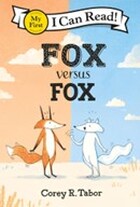 Fox versus Fox (Fox #6). Corey R. Tabor. (2024). Balzer + Bray. When Fox, the red fox first introduced in Fox the Tiger (2018), meets a white fox also named Fox, he is determined to show that they both can’t be foxes by pointing out his foxy skills of doing tricks, being sneaky, and jumping, all of which the white fox can do as well, although in a different way. However, when the competition accelerates to jumping higher and takes them soaring up into the sky, they both realize that foxes cannot fly. Bravely facing disaster, they cling together as they fall, plunging into a lake and finding out the foxes can swim—and can be friends. Corey R. Tabor’s humorous illustrations and use of short sentences and repetition of words in his latest Fox tale makes this “My First I Can Read!” book prefect for shared reading between an adult and emergent reader. Consider sharing earlier books about this tricky fox while waiting for the next book in the series, Fox Plays Ball, to be released in October. (PreS Up) —CA 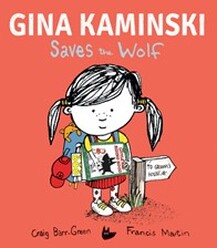 Gina Kaminski Saves the Wolf (Gina Kaminski #2). Craig Barr-Green. Illus. by Francis Martin. (2024). Kane Miller. Meet Gina Kaminski, a creative, spirited, neurodivergent little girl who thinks in threes. She begins by telling readers three reasons why school is “rubbish” on that particular day because her classroom is “too hot,” “smelly,” and “loud,” referencing her chart with emojis she uses to describe her feelings. When she has the opportunity to go to the more “sensory-friendly” reading room where Anya reads Little Red Riding Hood to her, Gina proclaims that Little Red Riding Hood and the Wolf made three big mistakes. She decides to visit fairy-tale land so that she can fix the mistakes in the story—and perhaps also her feelings about her day at school. Through sketch-like, animated illustrations, Francis Martin artfully captures Gina’s feisty nature and determination to make things right for the wolf. Watch for Gina’s next adventure, Gina Kaminski Rescues the Giant, out in August. (PreK-Gr 2) —NM 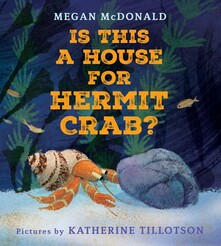 Is This a House for Hermit Crab? Megan McDonald. Illus. by Katherine Tillston. (2024). Neal Porter. When Hermit Crab grows too big for the shell on his back, he crawls out of the water and searches along the sandy beach for a new house that will hide him from predators. “He stepped along the shore. / by the sea, in the sand . . . / scritch-scratch, scritch-scratch . . .” He finds various things including a rock, a tin can, a small plastic pail, and a fishing net, none of which are suitable to be his new house. When a big wave washes Hermit Crab back out to sea, he finally finds the perfect house, the empty shell of a sea snail, just in time to avoid being devoured by a prickly porcupine fish. This new edition of Megan McDonald’s classic picture book (originally published in 1990 with illustrations by S. D. Schindler) is complemented by Katherine Tillotson’s colorful mixed-media artwork. Back matter includes an author’s note and a new informative “More About Hermit Crabs” section. (PreK Up) —CA 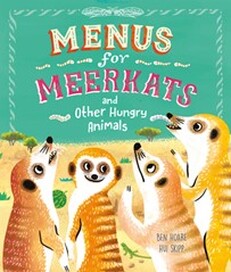 Menus for Meerkats and Other Hungry Animals. Ben Hoare. Illus. by Hui Skipp. (2024). Kane Miller. In this informational companion to Maps for Penguins and Other Traveling Animals (2023), young readers learn about the eating habits of ten hungry animals from around the world: meerkats, scarlet macaws, grizzly bears, great white sharks, koalas, dung beetles, orangutans, Indian cobras, blue whales, and lions. For each animal, Ben Hoare presents a “menu” broken down into main course, sides, and drinks. For example, the scarlet macaw enjoys nuts, fruits, and leaves for its main course while having sap and clay as sides and drinking water from rivers, streams, and pools in the rain forest. An additional “dinner with …” double spread provides facts about the animal’s size, habitat, and where they fit in the food chain. Hui Skipp’s brightly colored and richly detailed illustrations invite readers to look closely at what they reveal. A glossary and an index are included. (PreK Up) —NM 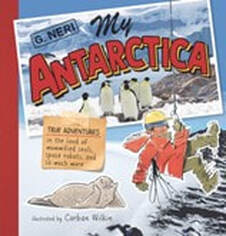 My Antarctica: True Adventures in the Land of Mummified Seals, Space Robots, and So Much More. G. Neri. Illus. by Corban Wilkin. (2024) Candlewick. G. Neri tells the true story of how his childhood dream of being an explorer came true in this memoir of his epic seven-week journey to “the most extreme place on Earth” made possible by a grant from the National Science Foundation Artists and Writers Program. Neri’s chatty field guide to Antarctica is a record of his adventures while based at McMurdo Station with scientists and support staff in the form of a scrapbook filled with captioned color photographs (many taken by Neri), cartoon illustrations with dialogue balloons created digitally by Corban Wilkins, maps, diagrams, and numerous interest-catching lists, such as “Things You Won’t Find in Antarctica” versus “Things You Will Find,” and “Critters of Antarctica, Neri kept in a notebook. Back matter includes an author’s note, miscellaneous “facts and stuff” about the continent, a ‘”Big Questions About Antarctica” section, recommended source material (books, films/TV, and websites), acknowledgments, photo credits, and an index. (Gr 3-5) —CA 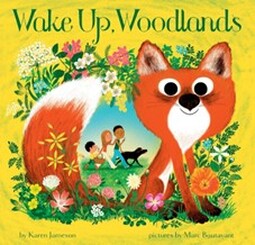 Wake Up, Woodlands. Karen Jameson. Illus. by March Boutavant. (2024). Chronicle. “Wake up, Little Whiskers. / No more storming / Woods are warming / Sweep your sleepy dreams away. / Scamper out to meet the day.” Author Karen Jameson and illustrator Mac Boutavant’s follow-up to Woodland Dreams (2020) paints a picture of spring awakening in the forest through a lively rhyming text and double-page spreads of digital artwork with rich detail. They offer vignettes that provide glimpses of baby animals, including bunnies, a honey bee, and a bear cub, being awaken and encouraged to greet the new day as a mother, father, child, and dog hurry on their way through the woodlands in a spring celebration of their own. Together, the text and illustrations create a feeling of hope and anticipation for a joyful start to a new day in spring. (PreK-Gr 2) —NM Nicole Maxwell is an associate professor specializing in literacy instruction in the Elementary and Special Education Program at the University of North Georgia. Carolyn Angus is former Director of the George G. Stone Center for Children’s Books, Claremont Graduate University, Claremont, CA.
Mary Ellen Oslick, Tracey Hodges, Jeanne Gilliam Fain, Bethany Scullin, Lesli Morris, and Emily Reed This second column on the 2024 Notable Books for a Global Society features picture books and novels that are informative and intriguing. Committee members are delighted to share their reviews of the award winners. Members of the Children’s Literature and Reading Special Interest Group will find additional resources such as teaching suggestions and related books in the spring 2024 Dragon Lode article. 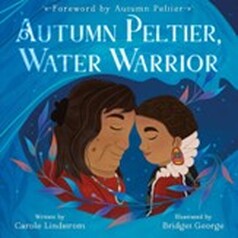 Autumn Peltier, Water Warrior. Carole Lindstrom. Illus. by Bridget George. (2023). Roaring Brook. Anishinaabe/Métis author Carole Lindstrom’s poetic texts and Anishinaabe artist Bridget George’s stunning illustrations bring to life the story of water warrior and activist Autumn Peltier (b. 2004) and her great-aunt, Josephine Henrietta Mandamin (1942-2019), told from the perspective of water itself. Indigenous water protectors traditionally care for and ensure clean water for seven generations into the future. Following colonization, the water was not as clean as it used to be. That is until Josephine fought for water rights by walking the circumference of Lake Superior taking 35 days (the full story is detailed in the back matter). Josephine taught and inspired future water warriors. Her great-niece Autumn Peltier meets with leaders all over the world, including the United Nations, advocating for Indigenous and water rights as she looks seven generations into the future. Back matter includes additional information on Josephine Mandamin and Autumn Peltier and their environmental activism. (PreK Up) —LM 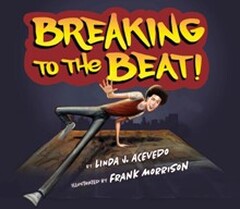 Breaking to the Beat! Linda J. Acevedo. Illus. by Frank Morrison. (2023). Lee & Low. The cacophony of rhythm and sounds of 1970s Bronx is captured on the pages of Linda J. Acevedo’s debut picture book complemented by Frank Morrison’s expressive acrylic artwork. Readers follow Manolo from his Puerto Rican roots listening to the beats of the conga to battling for hip-hop pride on the streets. As his neighborhood crumbles around him due to negligent landlords and corrupt politicians, he practices his moves and finds his groove. “Foot work of the TOPROCK. / Drop of the SIX-STEP. / Pose of the BABY FREEZE” until he is known as KID FLEX. Combining all types of dance moves, Manolo and some friends form the dance crew Borinquén Breakers, eventually dancing for the whole world to see in the 1980s. In an afterword, Acevedo explains that Manolo is a composite of the breakers and dance crew members of the time period. The back matter includes a glossary of break-dancing terms, an author’s note, acknowledgments, and sources for learning more about breaking. (PreK Up) —LM 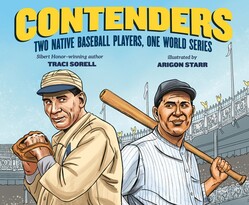 Contenders: Two Native Baseball Players, One World Series. Traci Sorell. Illus. by Arigon Starr. (2023). Kokila. The true story of Charles Bender (1884-1954) and John Meyers (1880-1971), the first Indigenous professional baseball players to play against each other in a World Series, comes to life in Traci Sorell’s picture book. Enduring the racial slurs of newspapers and baseball fans throughout their careers, Charles (Ojibwe-German American) and John (Cahuilla-German American) were no strangers to adversity. As a child, Charles was sent to an Indian boarding school in Philadelphia that forced him to assimilate into white culture and religion, while John was raised on a reservation by a single mother in Southern California. Both grew up loving to play baseball and made it to the major league. Charles became a pitcher for the Philadelphia Athletics and John a catcher for the New York Giants. Contenders tells the story of Charles and John and their facing each other in the 1911 World Series, but it also tells the story of the continual degradation of Indigenous peoples especially in sports. Back matter includes an author’s note, a time line, sources of quotes, and resources readers can explore to learn more about the significance of the 1911 World Series and the impact Bender and Meyers had on baseball. (PreK Up) —LM 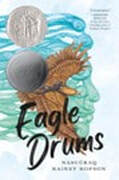 Eagle Drums. Nasuġraq Rainey Hopson. (2023). Roaring Brook. Readers learn the origin of the Iñupiaq Messenger Feast, a Native Alaskan tradition, in this middle-grade magical realism novel. Young Piŋa is helping his family prepare for winter when he meets the eagle god, Savik, at the top of a mountain and is forced to follow him on an arduous journey to the home of the eagle gods. Once there, Savik and the Eagle Mother teach him to create drums, use songs to share stories, choreograph dances, work with others, and finally construct a qalgi (a place for community activities), all these lessons necessary for him to carry out Eagle Mother’s condition for letting him go back to his family. He has two winters to construct a new qalgi and invite strangers to a feast with song and dance. In an author’s note, Nasuġraq Rainey Hopson shares that this story has been passed down orally for generations and that she was inspired to write Eagle Drums after attending her first Messenger Feast. (Gr 3 Up) —MEO 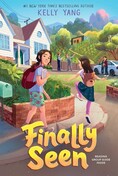 Finally Seen. Kelly Yang. (2023). Simon & Schuster. Lina Gao, a ten-year-old Chinese girl, feels like she is the “left behind girl.” She has been living in Beijing with her grandmother for the past five years while her parents immigrated to America to study and build a new life. Lina, who is teased by her classmates in China for being abandoned by her family, finally gets to join her family in Los Angeles. However, life in the U.S. is not what she expected. She struggles with speaking English, connecting with her parents and younger sister, and missing her grandmother. She learns that life in America is not as wonderful as she had been led to believe. Her family has faced hardships earning enough money to pay for rent and food, learning who they can trust, and enduring racism. This engaging story shares the experiences of many immigrant families and reconciles with the challenges faced by those left behind and those working to build a better life. Kelly Yang’s author’s note provides the relatable inspiration for this story. (Gr 3 Up) —TH 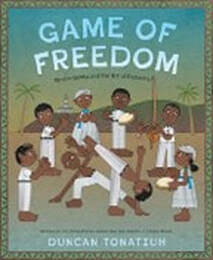 Game of Freedom: Mestre Bimba and the Art of Capoeira. Duncan Tonatiuh. (2023). Abrams. Duncan Tonatiuh offers readers a powerful, carefully constructed biography of Manoel Dos Reis Machado (1899-1974), known as Mestre Bimba, who cared deeply about elevating the street game of capoeira in which many formerly enslaved Africans in Brazil participated. He invited everyone around capoeira, including upper-class Brazilian society members and government officials, to see its beauty and value beyond the local community. Capoeira precisely integrates acrobatics, martial arts, dance, and music. Mestre Bimba created a school with specific regulated rules in an effort to teach capoeira at a high level in order so participants could develop their craft and everyone would honor and respect the game. Strong back matter includes a glossary (with pronunciation guide), an extensive author’s note with different origin stories of capoeira and photographs, endnotes, and a bibliography. (Gr 3 Up) —JFG 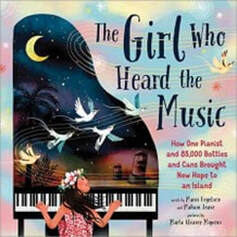 The Girl Who Heard the Music: How One Pianist and 85,000 Bottles and Cans Brought New Hope to an Island. Marni Fogelson & Mahani Teave. Illus. by Marta Álvarez Miguéns. (2023). Sourcebooks eXplore. Imagine living 1,000 miles away from any other place. That is where a girl named Mahani lived on an island called Rapa Nui, also known as Easter Island. A talented musician, she grew up taking music lessons on the island's only piano. After many years, Mahani moved away to become a concert pianist. As Mahani toured the world, her island always remained close to her heart. She wanted to help the island that struggled with ocean trash. When she returned to Rapa Nui, she had a bigger dream of saving the island by creating a music school with recycled trash. While other children experienced music for themselves at the school, the building also supported solar panels and a food garden. The back matter includes information on the island's culture, their people, and how the citizens used recycling and conservation to improve their island. (PreK Up) —ER 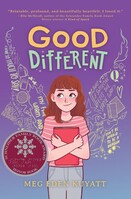 Good Different. Meg Eden Kuyatt. (2023). Scholastic. Written as a novel in verse, this extraordinary book tells the story of a neurodivergent girl who comes to understand and celebrate her differences. Readers will feel the pain and turmoil Selah goes through as she struggles to be one person in school and another person at home and feels she needs to wear a mask to hide her true self. One day she reaches a tipping point and hits another student. Her friends pull away, and the school threatens to expel her. Her world of rules and comfort begins to fade away. As Selah begins to figure out who she is, she comes to understand that different doesn’t mean damaged; it just means different. Using poetry to express her feelings, she finds that these poems connect her to fellow classmates in powerful ways and discovers the value of being open and vulnerable. (Gr 3 Up) —ER 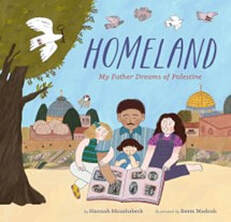 Homeland: My Father Dreams of Palestine. Hannah Moushabeck. Illus. by Reem Madooh. (2023). Chronicle. Hannah, along with her two sisters, loves to listen to her father’s nightly stories, especially the ones about visiting his grandparents in the Old City of Jerusalem. This autobiographical picture book highlights her father’s stories, showing life in Jerusalem, rich in Palestinian culture and experiences. The story balances fun moments like street vendors and family times with the heartbreaking reality of being unable to return to their homeland. Throughout the book, pigeons emerge as powerful symbols of peace and are a recurring theme connecting to Palestinian hopes. Inviting illustrations help convey a story about family, tradition, and identity, offering a perspective that is meaningful and relevant today. The book ends with a glossary, a note from the author, and family photos that ground Homeland in real experiences and make it a timely read. (PreK Up) —BS 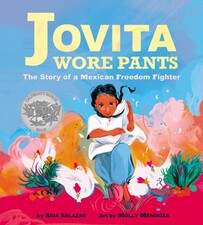 Jovita Wore Pants: The Story of a Mexican Freedom Fighter. Aida Salazar. Illus. by Molly Mendoza. (2023). Scholastic. This is the true story of Jovita Valdovinos (1911-1996), who grew up wearing big skirts and dreaming of having the freedom to wear pants like her brothers in the 1910s in rural Mexico. She was a true heroine who didn't fit into her time period. When her Papá joined the revolutionary Criteros fighting for their rights against the Federation, Jovita wanted to be a soldier too. Jovita continually had to fight for her rights as a young woman and was often refused the right to participate in the civil rights fights. Jovita then decided to take matters into her own hands and she forced her skirts into her bloomers and used them as "pants." After several family members were killed by the government, she would not let the conventions of the times hold her back. She cut her long hair, wore overalls, and a straw hat and became a revolutionary known as Juan. Back matter includes an extensive “More About Jovita” section with captioned photographs, and author’s and illustrator’s notes. (PreK Up) —JGF 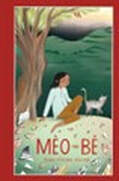 Mèo and Bé. Doan Phuong Ngyuen. Illus. by Jesse White. (2023). Lee & Low. Set in Vietnam during the 1960s, Mèo and Bé is a heart-wrenching tale of hanging on to hope despite abandonment and betrayal. When the war comes to their city, Bé and her mother move into her father’s home as his illegitimate daughter and mistress. Big Mother, her stepmother, frequently takes out her jealousy and anger on Bé, especially after Bé’s mother is driven out of the house. Bé stops talking and works as a servant in her own home but finds solace in caring for an injured kitten that she names Mèo. Big Mother eventually sells Bé, who manages to escape a life of captivity with other imprisoned young girls and women during a violent uprising. Somehow Bé is able to hold on to her beloved Mèo and even makes a new friend, Ngân, who becomes a sister to her and helps her find her voice again. (Gr 6 Up) —MEO 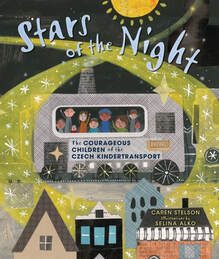 Stars of the Night: The Courageous Children of the Czech Kindertransport. (2023). Caren Stelson. Illus. by Selina Alko. (2023). Carolrhoda. “War.” The words escaped from our father’s lips. War. We knew the word, but what would war mean for us? We were soon to find out.” Imagine having to make the gut-wrenching decision to put your child on a train, not knowing if you will ever see them again. Imagine watching that train lurch forward with your child as you wave until the train disappears down the tracks. This seemingly impossible scene is what Jewish parents experienced in Czechoslovakia in 1938, before the start of World War II. This story, told from the perspective of a child fleeing their home as a refugee, shares the experience of the Kindertransport that Nickolas Winton helped organize and whose Winton’s heroic efforts saved 669 Czechoslovakian Jewish children from the Nazis. The back matter contains six pages dedicated to historical background information, a detailed timeline, author’s and illustrator’s notes, source notes, a selected bibliography, and recommended further reading. (Gr 3 Up) —BS 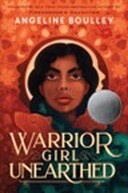 Warrior Girl Unearthed. Angeline Boulley. (2023). Henry Holt. Heists, a team of self-proclaimed misfits, and a legal battle combine for a heart-pounding mystery set in the world readers came to love in The Firekeepers Daughter (2021). Perry Firekeeper-Birch, “niece” to Daunis, is looking forward to a summer of fishing and few responsibilities. After she wrecks Auntie Daunis’ jeep, her “Summer of Slack” changes to a summer of responsibility. To repay her Auntie, she takes an internship at the local tribal museum working for Cooper Turtle, a polarizing advocate for funereal artifacts. Perry learns of the Native American Graves Protection and Repatriation Act (NAGPRA) which seeks to return stolen artifacts, many of which are displayed in universities or museums, to their native tribes. Interweaving laws and well-researched history, Angeline Boulley takes Perry and readers on an adventure to reclaim her Anishinaabe heritage and become an advocate in this fast-paced mystery that will keep readers hooked until the very end. (Gr 9-12) —TH Mary Ellen Oslick, Chair of the 2024 NBGS Committee, is an associate professor at Stetson University, DeLand, FL. Tracey Hodges is the owner of The Empowering Advocate, LLC, in Austin, TX. Jeanne Gilliam Fain is a professor at Lipscomb University in Nashville, TN. Bethany Scullin is an associate professor at the University of West Georgia, Carroltton, GA. Lesli Morris is a teacher specialist at Canyons School District in West Jordan, UT. Emily Reed is a Literacy Specialist at Northern York County School District in Dillsburg, PA.
|
AuthorsThese reviews are submitted by members of the International Literacy Association's Children's Literature and Reading Special Interest Group (CL/R SIG). Archives
March 2024
Categories
|

 RSS Feed
RSS Feed